The Terrestrial Biogeochemistry and Paleoclimatology lab at Brown had a busy 2023 with many milestones and some of our first departures from the research group. This December we said farewell to postdocs Kristina Butler and Natasha Sekhon, who will start faculty positions at UT Dallas and Occidental College, respectively. Both Natasha and Kristina have been integral to our lab group’s activities over the past several years and we look forward to many more years of fruitful collaborations studying caves, (past) hydroclimate, and lithium. Additionally, Jesse Miller and Shaw Miller completed their senior theses with our group in May and December, respectively, and Ted Bobik is currently completing his Sc.M. thesis with us in the coming weeks. In September we welcomed co-advised graduate student Mónica Geraldes Vega who comes to us from Mount Holyoke College and in October we welcomed postdoc Gavin Piccione who recently received his PhD from from UC Santa Cruz. We look forward to Mónica and Gavin’s contributions to our group’s research program as they settle in at Brown.
It has been incredibly rewarding to see group members thrive, creatively pursue their scientific interests, and present their work to the scientific community. Collectively our group has many interests and motivations that lead us to test hypotheses and interrogate aspects of the Earth system in a variety of different ways using both modern landscapes and paleoclimate archives, and using a plethora of different geochemical, spatial, and modeling techniques. We are continually reminded in our work that “the past is the key to the future” and that “the present is the key to the past” in our discussions. Specific highlights from this year include:
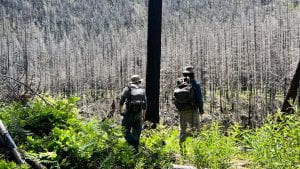
We went to the field to study sediments, caves and watersheds in the Oregon Cascades, Great Basin, southcentral Alaska, and numerous caves plus the Zambales ophiolite in the Philippines. Pictured: Jonah Bernstein-Schalet and Sebastian Muñoz at the Beachie Creek Burn Scar, Oregon.
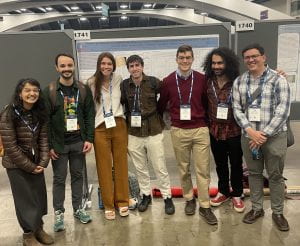 Presentations by 8 group members at the AGU Fall Meeting, including three undergraduate posters and talks by postdoc Natasha Sekhon, Sebastian Muñoz and Daniel Ibarra. Pictured (L-R): Natasha Sekhon, Evan Ramos, Celia Kong-Johnson, Jonah Bernstein-Schalet, Shaw Miller, Sebastian Muñoz and Daniel Ibarra. In total we contributed to 34 presentations or posters at scientific conferences in 2023!
Presentations by 8 group members at the AGU Fall Meeting, including three undergraduate posters and talks by postdoc Natasha Sekhon, Sebastian Muñoz and Daniel Ibarra. Pictured (L-R): Natasha Sekhon, Evan Ramos, Celia Kong-Johnson, Jonah Bernstein-Schalet, Shaw Miller, Sebastian Muñoz and Daniel Ibarra. In total we contributed to 34 presentations or posters at scientific conferences in 2023!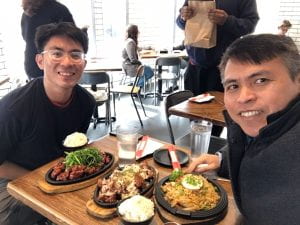
Visitors to the lab included Dr. Jaivime Evaristo from Utrecht University, Bryce Belanger from Vanderbilt University, Jiquan Chen from China University of Geosciences, Beijing and Christopher Emproto from University of Michigan. Pictured: graduate student Justin Custado and Jaivime Evaristo at lunch in Providence.
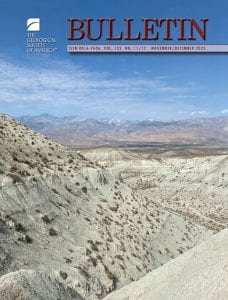 Graduate student Catherine Gagnon’s paper on paleoclimate controls on lithium resources was highlighted on the cover of GSA Bulletin! This paper was the first data paper from our lab and included former undergraduate Annabelle Gao and postdoc Kristina Butler as co-authors. It also represents some of the first data published from our new shared Kiel IV and 253+ setup. In total our group contributed to the publication of 15 peer review papers with several papers led by graduate students and postdocs set to come out in early 2024.
Graduate student Catherine Gagnon’s paper on paleoclimate controls on lithium resources was highlighted on the cover of GSA Bulletin! This paper was the first data paper from our lab and included former undergraduate Annabelle Gao and postdoc Kristina Butler as co-authors. It also represents some of the first data published from our new shared Kiel IV and 253+ setup. In total our group contributed to the publication of 15 peer review papers with several papers led by graduate students and postdocs set to come out in early 2024.
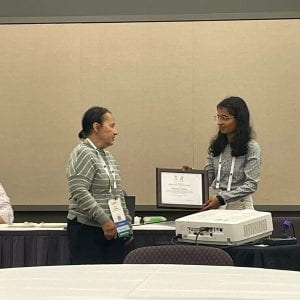
Other highlights included postdoc Natasha Sekhon being honored with the GSA Karst Division Early Career Award at the Geological Society of America. Sebastian Muñoz advancing to candidacy after an unqualified pass at his preliminary exam. Plus new grants being funded including a DOE grant with Rice University led by postdoc affiliate Evan Ramos to work on the East River watershed in Colorado, an NSF P4Climate grant with Matthew Kirby at CSU Fullerton to study glacial Lake Mojave and an NSF RAPID grant with Jeremy Caves Rugenstein at Colorado State to study water isotopes in the western United States. Undergraduates Marina Benson and Jonah Bernstein-Schalet were awarded IBES Voss Undergraduate Fellowships.
Finally, new laboratory techniques were set up this year including the IBEX peripheral enabling carbonate clumped isotope measurements on a more diverse suite of sample types and a microvolume addition to our silicate triple oxygen isotope mass spectrometer allowing us to push down sample size requirements! Further, our triple oxygen isotope lab has already contributed to >10 meteorite classifications over the last ~18 months with more forthcoming. In the coming year we anticipate increasing our focus on work in our trace metals laboratory to establish new isotope system capabilities as a research group.